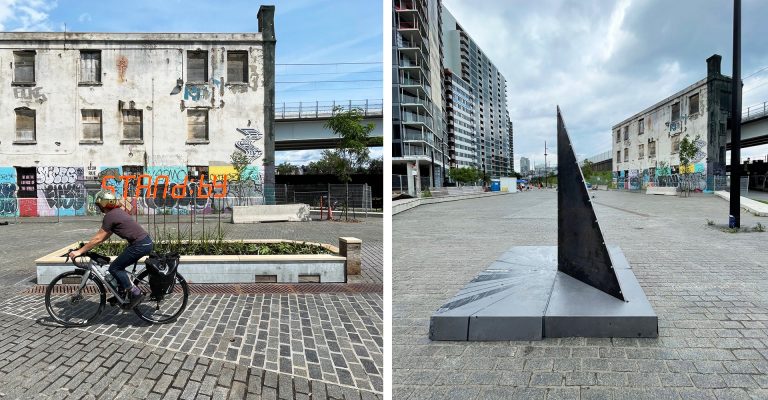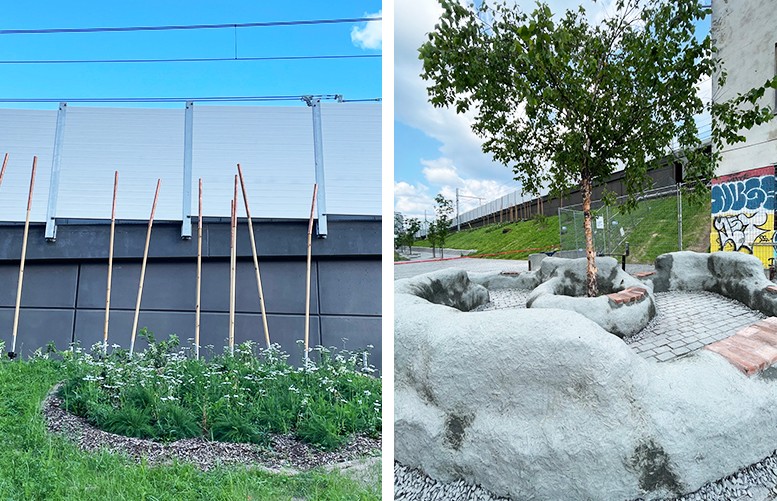An interuniversity cohort of 19 students installs 4 temporary artworks at Griffintown’s Place des Aiguilleurs

Commuters and passersby of Montreal’s newly launched light-rail Réseau express métropolitain (REM) can enjoy the installation of four temporary public artworks at Place des Aiguilleurs in the Griffintown neighbourhood. The installation is the result of a collaborative effort by students in a Concordia summer course in public art and sustainability.
“We’ve had a lot of fun so far; the group has been fantastic,” says artist Yann Pocreau. He joined Concordia studio arts assistant professors Kelly Jazvac and Juan Ortiz-Apuy to mentor 19 students from the four major Montreal universities — Concordia, UQAM, McGill and Université de Montréal.
The REM financed the project in connection with the Politique d’intégration des arts à l’architecture et à l’environnement du Ministère de la Culture et des Communications (la politique du 1%). The class was the first of four in a series, to be held once at each of the universities.
Connecting communities, connecting universities
Undergraduate and graduate students from various disciplines participated, and instructors made a point that all four groups comprise students from each university. “It’s a very diverse group,” notes Marie-Justine Snider, curator for the art collections of the Caisse de dépôt et placement du Québec.
As a former UQAM student, Snider says she experienced firsthand how disconnected the universities can feel. “If you have four universities in the same city, we have to find ways to be linked,” Snider notes.
She adds that the REM’s “whole system of transportation is based on the idea of bringing people together more efficiently and with a system that doesn’t pollute. So I thought it was a great idea to bring the four universities together.”
Ortiz-Apuy explains that collaboration was a big part of the learning objective. Students came up with ideas as a team and together decided what interested them most about the site and how they would respond to it.
As Jazvac notes, “Snider’s vision was to give students the opportunity to work on something at a one-per-cent level — a public artwork.”
Part of making this possible was to have the artworks be temporary, “which is getting more common in public art practices as a way to do things you couldn’t normally do with materials,” she adds.
 Left: "Undulating appearance as a pulse led by time like a movement fed by space between vibration and territory," 2023, by Clothilde Allen, Julie Robert, Julia Martinez-Turgeon and Olivier Beaudoin. | Right: "Dés.orientations (sit if you’d like)," 2023, by Isabelle Anguita, Sarah Cloutier, Laurie Michaud and Danica Olders.
Left: "Undulating appearance as a pulse led by time like a movement fed by space between vibration and territory," 2023, by Clothilde Allen, Julie Robert, Julia Martinez-Turgeon and Olivier Beaudoin. | Right: "Dés.orientations (sit if you’d like)," 2023, by Isabelle Anguita, Sarah Cloutier, Laurie Michaud and Danica Olders.
The afterlife of public art
Just as the REM aims to cut down on pollution, students were encouraged to consider the afterlife of their projects. Pocreau discloses that this was part of the conversation throughout the class and that sustainability in art-making is something that all the students care about.
Many students worked with recuperated materials, Ortiz-Apuy reports. “They all needed to think, once they install something, what happens to those materials? Where can they go? How can they be useful? How can they be reused in another purpose?” he says.
“It’s very much an inherent part of the exercise.”
A complex space
“All the pieces consider the site really specifically,” Jazvac notes, adding that one group “has been studying the path of the sun really carefully to make a type of sun dial.”
She says that students were very deliberate about the positioning of their sculpture “to get the effects that they wanted and point to the things that they wanted people to think about.”
A second project underway is a scaled-down version of Montreal landmark Wellington Tower’s inaccessible rooftop. Bringing it down to street level, this roof becomes a space that can be enjoyed by the community.
Another project takes the form of an adobe labyrinth that doubles as a seating area. Offering a reprieve from the commotion of the space, seeds embedded within are hoped to grow and echo the many weeds that grow through cracks in the surrounding pavement.
Pocreau reports that a fourth project considers sound, vibrations and sound pollution. He explains that wooden poles topped with copper cups react to the wind and the vibrations of the REM as it passes.
Snider describes the space as very complex: “There’s a lot going on, which is always interesting for public art.”
Pocreau and his fellow instructors encourage the public to visit the site and join them for a vernissage August 30 from 5 to 7 p.m. at Place des Aiguilleurs. The artworks will be on display until October.
“They’ve worked so hard, and the quality and enthusiasm are there for all to see.”
Learn more about Concordia’s Department of Studio Arts.
The public is invited to the installation’s vernissage at Place des Aiguilleurs in Montreal’s Griffintown neighbourhood on August 30 from 5 to 7 p.m.




